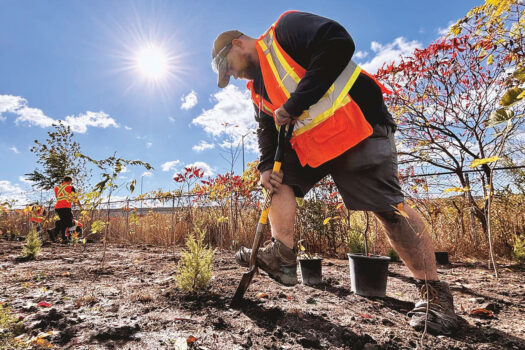By Pam Charbonneau
OMAFRA turf specialist
 Two years ago we had the winter that wasn’t. This year we are having a very memorable winter. It all began with snow cover in late November that stayed on the ground until the second week of January. There was a long enough snow-free period for golf superintendents, who didn’t get their preventative snow mould treatments on, to still get the job done. Since then, it has been snow, rain, freezing rain, snow and more snow. There were all sorts of precipitation records broken in the month of February 2008. These were a result of rain, freezing rain or ice pellets, as well as snowfall. Records were also broken for snowfall in March. As of this writing, it isn’t even half over. And, at this point it looks like spring is still a long way off.
Two years ago we had the winter that wasn’t. This year we are having a very memorable winter. It all began with snow cover in late November that stayed on the ground until the second week of January. There was a long enough snow-free period for golf superintendents, who didn’t get their preventative snow mould treatments on, to still get the job done. Since then, it has been snow, rain, freezing rain, snow and more snow. There were all sorts of precipitation records broken in the month of February 2008. These were a result of rain, freezing rain or ice pellets, as well as snowfall. Records were also broken for snowfall in March. As of this writing, it isn’t even half over. And, at this point it looks like spring is still a long way off.
What can we expect to see this spring? The snow cover will give lots of shelter to voles which are probably having a field day eating grass under the snow, safe from predators such as owls. There was probably just a long enough snow cover to develop gray snow mould. It requires roughly 90 days of continuous snow cover to develop. Conditions were certainly favourable under the snow for the development of pink snow mould.
Last fall was a good year for European chafer damage. Many areas that were not treated had grub damage by the beginning to the middle of October. There could be some new damage evident when the snow melts this spring. Where leatherjackets are concerned, adults were laying eggs into extremely dry soil in September. Knowing that leatherjacket eggs require moisture to develop, the prediction is that there will be fewer leatherjackets this year.
On the subject of leatherjackets, during last spring it was confirmed there is a new species of crane fly in Ontario. It is the common crane fly, Tipula oleracea. It is thought to have two generations per year in this area. Adults fly in May and again in September, unlike the European crane fly, where adults only take flight in September. We are interested in finding out more about this new species of crane fly. We are asking for the assistance of golf courses, lawn care companies and sod farmers in Ontario. If you see adult crane flies in flight during the month of May, I would appreciate you contacting me by phone or by email (see end of article). I hope to collect samples and identify them to determine where in Ontario this new species currently exists.
Despite dry conditions this summer and fall, weed counts on our turf research plots were lower than in previous falls. This bodes well for the spring. Hopefully, the turf that was treated with a late fall fertilizer application will get a jump-start and out-compete the weeds.
There are some new products on the turf market and some label expansions to old products. Leatherjacket control has been added to the Merit label for turf, including sod farms. There is a new insecticide, Deltagard from Bayer, for control of hairy chinch bugs, sod webworm, cutworm and ants. Another very positive development is the registration of a bio-herbicide for the control of dandelions in turf called Sarritor.
On most people’s minds in the turf industry this spring is the provincial cosmetic pesticide ban. Just exactly what is covered in the ban is not known yet, but it will certainly have an impact on how turf managers manage turf. This will require some new technology and some new business approaches to maintaining healthy turf.
Pam Charbonneau can be reached at (519) 824-4120, ext. 52597 or by e-mail at pamela.charbonnea@ontario.ca.






